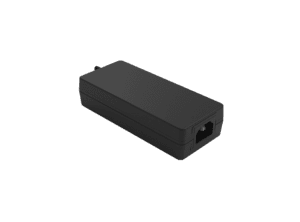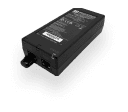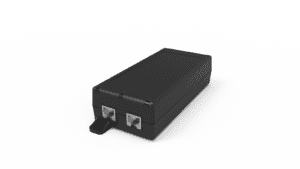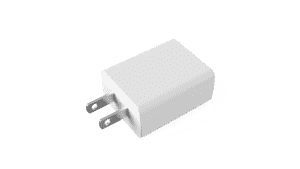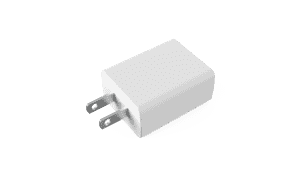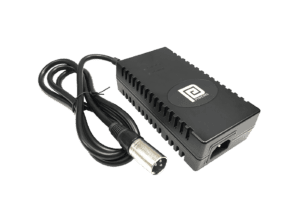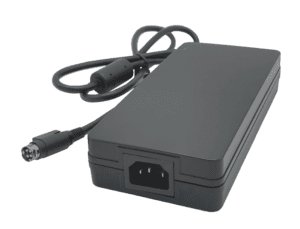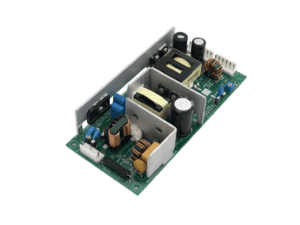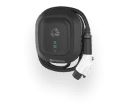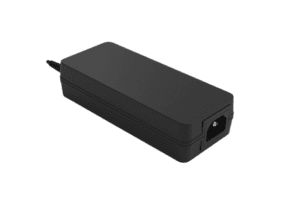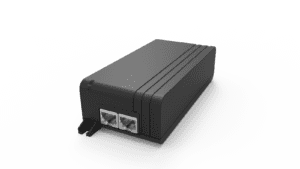BLOG
PoE Splitter: The Complete Overview of PoE Splitters in Network Installations
Table of contents
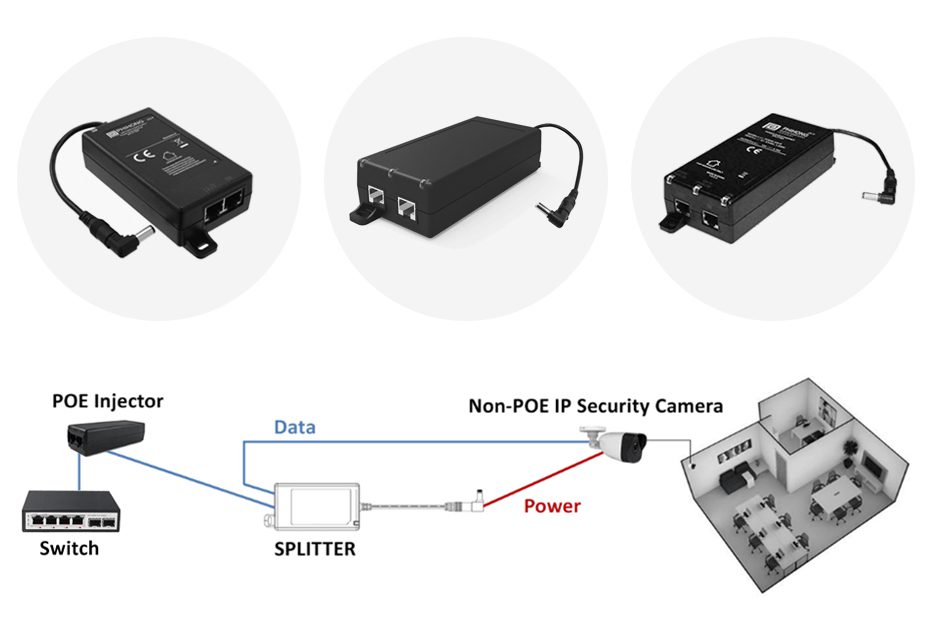
Welcome to our all-inclusive guide to Power over Ethernet PoE splitters! This guide is perfect for those who wish to power devices that do not support IEEE802.3 standards based PoE but want to utilize a PoE network infrastructure.
In this article, we’ll explore everything about PoE splitters. We’ll discuss their roles, advantages, and the most effective methods for incorporating them into network installations. So, let’s start!
Understanding PoE Technology
Before delving into PoE splitters, it’s crucial to understand the basics of PoE technology. PoE simplifies network installations by transmitting both electrical power and data over a single Ethernet cable, eliminating the need for separate power supplies. This technology is especially useful for devices like IP cameras, wireless access points (WAP), kiosks, and VoIP phones, often installed where power outlets are scarce.
What is a PoE Splitter?
A PoE splitter separates the power and data signals from a PoE-enabled Ethernet cable. It receives the combined power and data input and splits it into separate outputs for power and data. This allows non-PoE devices to utilize PoE infrastructure, simplifying the integration of various devices into your network.
How Does a PoE Splitter Work?
A PoE splitter works by connecting to a PoE-enabled Ethernet cable and splitting the power and data into separate outputs. Here’s a step-by-step breakdown:
PoE Switch and PoE Injector: With this setup, a PoE network switch connects to a PoE splitter using an Ethernet cable.
Non-PoE Switch and PoE Injector: This setup starts with a non-PoE network switch connected to a PoE injector via an Ethernet cable. The PoE injector then connects to a PoE splitter using another Ethernet cable.
Input Connection: The PoE splitter receives both power and data through a single Ethernet cable connected to the splitter’s RJ45 input port.
Splitting Process: The splitter’s internal circuitry separates the power and data signals.
Power Output: The higher voltage PoE input (56V DC) is converted to a fixed output voltage that the non-PoE device requires. The voltage output depends on the type of PoE splitter model that offers a fixed voltage (5V, 12V, 24V).
Data Output: The data signal is allowed to continue to connect to a device via a standard Ethernet connection.
Output Connections: The splitter provides two outputs: one for power (which typically uses a barrel connector), and one for data through an RJ45 output port, which goes into the input of the non-PoE device through an Ethernet cable.
Benefits of Using PoE Splitters
PoE splitters offer several advantages in network installations:
Flexibility: PoE splitters allow you to use existing PoE infrastructure to power non-PoE devices, providing greater flexibility in your network design.
Cost-Effective: By leveraging PoE technology, you can reduce the need for additional power supplies and electrical wiring, lowering installation costs.
Simplified Installation: PoE splitters make it easier to deploy devices in hard-to-reach areas.
Improved Safety: PoE technology is inherently safer, as it uses low-voltage power. This reduces the risk of electrical hazards and simplifies compliance with electrical safety regulations.
Types of PoE Splitters
Power over Ethernet (PoE) splitters are versatile devices tailored for specific applications, each type catering to distinct needs within network setups. Understanding these variations is crucial for optimizing PoE deployments. Here are the most common types of PoE splitters:
Pass-Through PoE Splitters
These splitters do not regulate the output voltage and are typically used for equipment that doesn’t have PoE front ends but have internal DC-DC converters. They pass through the power and data without any modification. Although they are more affordable than regulated output PoE splitters, their simplicity can also be a drawback in certain scenarios. Since they lack voltage regulation, pass-through PoE splitters can not be used for devices that require precise voltage levels. Additionally, the lack of standardized specifications for passive PoE can result in compatibility issues between different manufacturers’ equipment, requiring careful consideration during setup and deployment.
Regulated Output PoE Splitters
Regulated output splitters, unlike pass-through splitters, convert the output to a specific actively regulated voltage to perfectly match what each device needs, ensuring stable performance. This makes them super reliable and versatile. They also stick to standardized specs, which means less hassle with compatibility between different devices. Some even come with bonus features like surge protection, making your network setup more robust. Overall, if you’re looking for consistent performance and fewer headaches, regulated output PoE splitters are the way to go.
Selecting the Right PoE Splitter
Choosing the right PoE splitter for your network installation depends on several critical factors that depend on your Power Over Ethernet setup. Consider these scenarios first before deciding on what the best PoE splitter is for your needs:
Power Requirements
Selecting the appropriate voltage for your PoE splitter is crucial to ensure compatibility and reliable operation of your devices. Here’s how different voltage options can cater to specific scenarios:
- 5V PoE Splitters (IEEE 802.3af): These are commonly used for small, low-power devices such as VoIP phones or wireless access points (WAP) that operate on lower voltages. They are ideal for applications where power efficiency and compatibility with devices requiring lower voltage inputs are essential.
- 12V PoE Splitters (IEEE 802.3af or IEEE 802.3at): Devices like IP cameras often require 12V input. A 12V PoE splitter is suitable for these applications, providing sufficient power and minimizing voltage drop to maintain consistent camera performance and video quality.
- 24V PoE Splitters (IEEE 802.3af or IEEE 802.3at): Certain network equipment and industrial devices, such as access points or sensors, are designed to operate on 24V input. Using a 24V PoE splitter ensures these devices receive the necessary power without compromising performance, making them suitable for deployments in industrial or enterprise environments.
For these applications, Phihong offers a range of PoE splitters:
- POE14-050_R: Provides a stable 5V output, ideal for low-power devices like VoIP phones and WAPs.
- POE21-120-R and POE48-120BT-R: These splitters deliver reliable 12V output, suitable for security cameras and similar devices requiring stable power over extended distances.
- POE21-240-R: Designed for 24V applications, ensuring robust power delivery for industrial devices and network equipment.
Practical Applications of PoE Splitters
PoE splitters are essential components in various network installations, offering flexibility and efficiency. Here are some practical applications where PoE splitters prove invaluable:
IP Cameras:
Many IP cameras lack built-in PoE support. By using a PoE splitter, you can leverage your existing PoE infrastructure to power these cameras. This simplifies installation, reduces the need for additional power outlets near camera locations, and minimizes cable clutter.
Wireless Access Points (WAP):
Some wireless access points may not natively support PoE. Employing a PoE splitter allows you to provide power to these devices over Ethernet cables, enabling flexible placement in optimal locations without proximity to electrical outlets. This enhances network coverage and deployment options.
VoIP Phones:
Older models of VoIP phones may not be equipped with PoE capabilities. Integrating a PoE splitter facilitates their connection to PoE networks, ensuring seamless operation and compatibility with modern network setups. This approach streamlines deployment and maintenance of VoIP systems.
Kiosks / Point of Sales:
Kiosks and point of sales systems often require a constant power supply for uninterrupted operation. PoE splitters provide a reliable solution by delivering power over Ethernet cables, eliminating the need for separate power adapters and simplifying installation. This setup ensures seamless integration of kiosks and POS systems into PoE networks, optimizing customer interaction and transaction efficiency.
IoT Devices:
Many IoT devices require low-power DC inputs for operation. PoE splitters are designed to deliver stable power to these devices, accommodating their specific power requirements. This capability supports the deployment of IoT solutions across diverse environments, enhancing connectivity and operational efficiency.
By leveraging PoE splitters in these scenarios, network administrators can optimize their infrastructure, simplify installations, and reduce costs associated with additional power supplies and wiring. This versatility makes PoE splitters indispensable in modern network deployments.
Troubleshooting PoE Splitter Issues
While PoE splitters are generally reliable, you may encounter some issues during installation. Here are common problems and their solutions:
No Power Output: Double-check that the PoE source is active and supplying power. Verify the connections between the PoE-enabled Ethernet cable and the input port of the splitter. Ensure that the splitter’s power output matches the voltage and current requirements of your device. Also verify that the PoE power source being used is able to provide sufficient power to the PoE splitter and account for power loss across the Ethernet cable from the PoE power source to the splitter.
Intermittent Power: This issue can arise from a loose or faulty connection. Inspect all Ethernet and power connections to ensure they are securely plugged in. Additionally, confirm that the PoE source can deliver sufficient power to meet the demands of your devices, especially over extended cable distances.
Data Connectivity Issues: Ensure that the data output port of the splitter is correctly linked to the Ethernet port of your device. Examine the Ethernet cable for any signs of damage or poor quality that could impair data transmission. Confirm compatibility between your splitter and other network equipment to avoid data transfer inconsistencies.
Overheating: Overheating may occur if the PoE splitter is installed in a poorly ventilated environment or if it exceeds its maximum power handling capacity. Place the splitter in a well-ventilated location and adhere to the manufacturer’s specifications regarding power limits and operational conditions. This ensures optimal performance and longevity of the device.
By addressing these common issues proactively during installation and operation, you can enhance the reliability and effectiveness of your PoE splitter setup, ensuring seamless integration into your network infrastructure
Why Choose Phihong: The Leader in PoE Technology
Leading Innovation and Industry Influence
Phihong stands at the forefront of Power over Ethernet (PoE) technology, driven by our active involvement in the IEEE PoE Committees. As the only power supply manufacturer engaged in these crucial discussions, we consistently contribute to the evolution of future PoE standards. Our leadership and expertise position us as the go-to choice for businesses seeking cutting-edge PoE solutions.
Unmatched Reliability and Longevity
Designed for durability, Phihong’s PoE products ensure a minimum Electrolytic Capacitor (Ecap) life of three years at maximum load. This focus on reliability minimizes field failures and returns, solidifying our reputation for producing dependable, high-quality PoE solutions. Our customers can trust that our products will deliver consistent performance even under demanding conditions.
Over 50 Years of Industry Excellence
With over five decades of experience, Phihong has established itself as a beacon of reliability in the power electronics industry. We build our rich legacy on a foundation of efficiency and reliability, ingraining these qualities in every product we deliver. Our extensive experience allows us to deliver customized solutions that meet clients’ unique needs, backed by a proven track record.
Patented PoE Innovations
Phihong’s Patent No US 11.005.670 B2 showcases our PoE technology and commitment to energy efficiency. Our proprietary PoE technology underscores our leadership, offering OEMs cutting-edge solutions and robust intellectual property protection. Partnering with Phihong ensures that your products stand out in a competitive market with superior performance and compliance.
Other Reasons to Choose Phihong
U.S.-Centered Operations: For U.S. OEMs seeking customized PoE splitter solutions, partnering with Phihong is an obvious choice. Rooted in the heart of Silicon Valley, our inventory facility is strategically located near the biggest names in technology. With local R&D facilities and U.S.-based customer support, we offer unparalleled convenience and responsiveness for domestic OEM businesses.
Whether you’re looking for the perfect PoE splitter or in need of a custom solution, invest in a manufacturer with over half a century of innovation and dependability. Our legacy of excellence ensures your business benefits from the best PoE technology available, making us the brand of choice for discerning OEMs.
CLIENT'S QUOTE
Phihong's Power-Over-Ethernet solutions have transformed our network, boosting efficiency and reducing costs. Their seamless integration has simplified both installation and maintenance.
Explore More with Phihong USA
As we conclude our exploration of PoE technology, it’s clear that this field is experiencing unprecedented growth. For over 50 years, Phihong has been at the forefront of innovation, serving Fortune 500 companies across various industries as a leading power supply manufacturer for OEMs.
Phihong’s leadership, particularly in advanced technologies like Power over Ethernet, extends to active contributions in the development of IEEE PoE standards. This involvement underscores our commitment to innovation and dedication to providing cutting-edge power solutions that will shape the future of technology.
In addition to custom power supply solutions, Phihong offers a diverse range of products, including:
- Power over Ethernet (PoE) Solutions: PoE injectors, splitters, media converters, and more
- AC/DC Adapters and Power Supplies: USB adapters, desktop adapters, industrial-grade power supplies, and more
- Battery Chargers: Chargers for lithium-ion and lead-acid batteries
- Medical Power Supplies: Specialized power supplies that meet stringent healthcare requirements
By partnering with Phihong USA, you are choosing a trailblazer in power technology. If you’re an OEM looking for a custom PoE solution or just looking for a quality product, call us today: 510-445-0100 or email us at usasales@phihongusa.com. We look forward to collaborating with you.

Contact Our Team Today!
Our dedicated sales team and international partners are prepared to support you with your latest projects and initiatives globally.
FAQ
What is a PoE splitter? (in simple terms)
A splitter is a device that takes one input signal, like power or data, and divides it into multiple output signals. Imagine you have one source, like a cable or power line, and you want to send the signal to two or more devices— a splitter makes this possible by splitting the original signal into several parts, so each connected device can receive it simultaneously. This is commonly used in home entertainment systems, networking, or even with Power over Ethernet (PoE) setups to power multiple devices from one source.
What devices can benefit from using a PoE splitter, and how do I know if I need one?
A PoE splitter is essential for powering devices that do not natively support Power over Ethernet (PoE) technology but still need to be integrated into a PoE-based network. Common examples include IP cameras, wireless access points (WAP), VoIP phones, kiosks, and IoT devices that lack built-in PoE capability. If you have devices that require power and data over a single Ethernet cable but don’t support the IEEE802.3 standards, a PoE splitter enables these devices to connect to the network without needing separate power supplies . By using a PoE splitter, you can streamline the installation process, reduce cable clutter, and place devices in locations where power outlets are unavailable. To determine if you need a PoE splitter, consider whether your non-PoE device is located far from power sources, or if you want to leverage an existing PoE network without investing in new PoE-compatible equipment.
How do I choose the right PoE splitter for my network setup?
Selecting the correct PoE splitter for your network setup depends on several critical factors. First, consider the power requirements of your non-PoE device. PoE splitters come in different output voltages, typically 5V, 12V, or 24V, to match the needs of various devices. For example, smaller devices like VoIP phones or WAPs might require a 5V splitter, whereas IP cameras and industrial equipment may need 12V or 24V splitters. Additionally, assess the type of PoE network you have—whether it’s using a PoE switch, PoE injector, or a non-PoE switch with a PoE injector. The compatibility between your network equipment and the PoE splitter is crucial to ensure reliable operation. Regulated output splitters are often recommended for their ability to provide stable voltage and compatibility with different devices, while pass-through splitters might be suitable for applications with internal DC-DC converters. Lastly, consider additional features such as surge protection and voltage regulation if your network environment is prone to power fluctuations or requires enhanced reliability.

